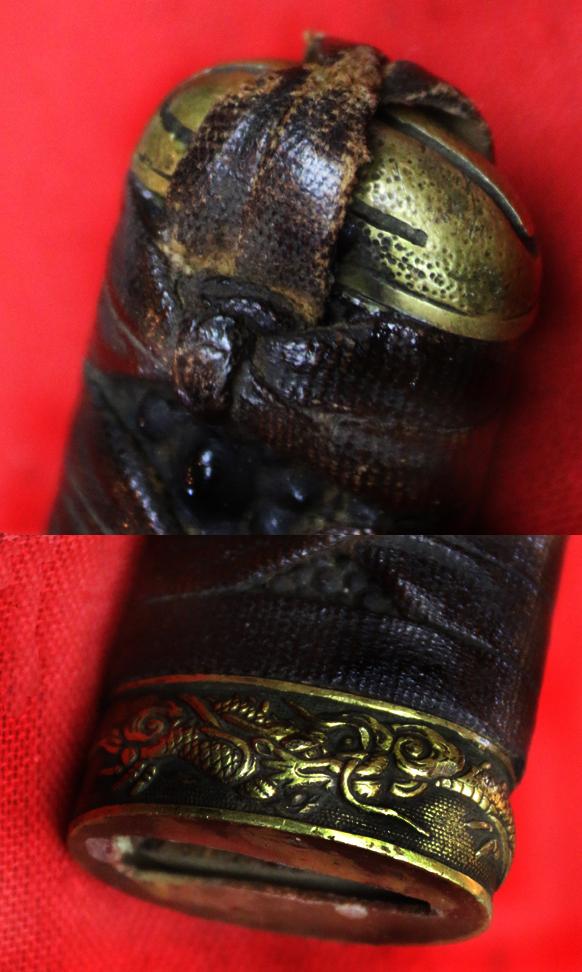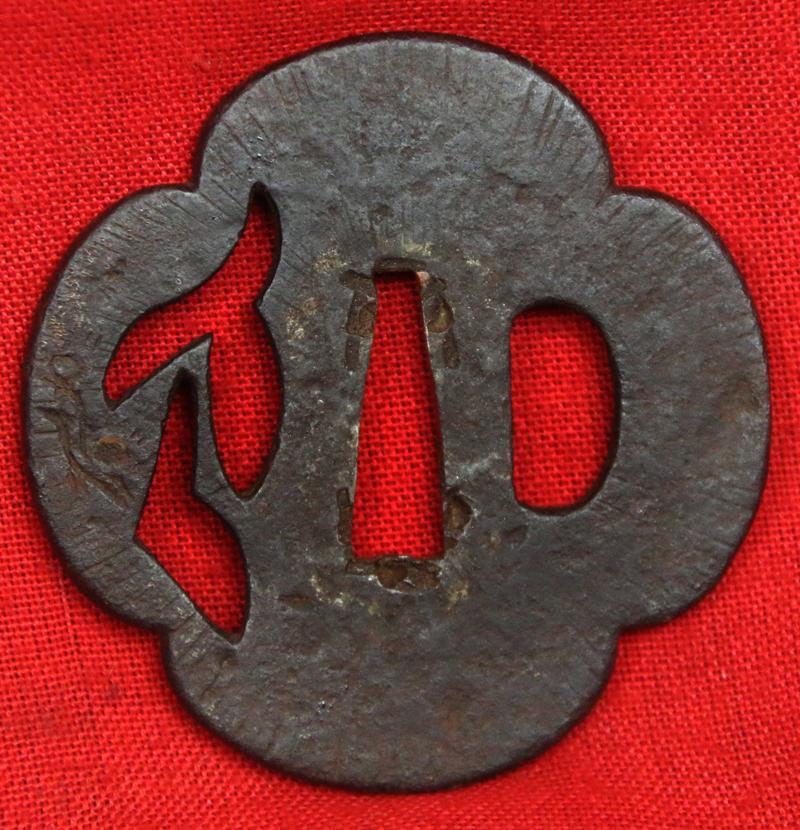A Superb 15th Century, Ancient, Signed Samurai Sword, From the Famous Sukesada Line of Early Samurai Sword Smiths
This sword is an absolute ancient beauty, in fabulous condition for its age.
As with all fine samurai swords that have been owned, cared for correctly, and appreciated for centuries, it’s blade condition belies its great age.
John Keats once wrote that ‘a thing of beauty is a joy forever’, well this sword has certainly been a joy for almost 600 years.
Made and signed by one of the early Sukesada school of master swordsmiths, in around 1450, between 570 to 600 years ago. The blade has a spectacular curvature and a typical, early, Koto period narrow suguha hamon [super hardened edge temper line]. The saya is in superb condition, with pristine and perfect bright black urushi lacquer. It is a great historical ancient sword with its last all original Edo period mounts. Edo iron sukashi pierced mokko tsuba, sinchu fushi kashira, and the fuchi is decorated with takebori dragon. It has a pair of dragon menuki under the original Edo period lacquered cotton tsuka-ito binding.
The Sukesada line of swordsmiths descended in the Osafune school and are recorded as far back as the end of the Nambokucho period (around 1394). This blade here is from around 1450, placing it in the pre Sue-Koto Period (1469-1596).
It is known that some Sue-Koto Sukesada swordsmith’s produced many swords (Kazu-uchi mono) in order to keep up with the demand of battlefield swords. Mainly for the samurai foot soldier where were the combat factor was far more important than the artistic beauty.
The early Sukesada smiths however produced swords of outstanding quality. This is from one of the early pre Sue-Koto period Sukesada smiths. The Sukesada line of swordsmiths extend into the Bizen tradition with its roots coming from the Ichimonji line. (For those unaware, The Ichimonji swords of the Kamakura period are perhaps some of the finest swords to have ever been made, many would say these far exceed even Masamune in terms of quality and artistic beauty). The Bizen sword making tradition has long been considered the largest of sword making traditions, this has much to do with the Sukesada swordsmiths. Bizen Province was a province of Japan on the Inland Sea side of Honshu, in what is today the southeastern part of Okayama Prefecture. It would become home to what would be the biggest of the 5 mainline sword making traditions ( Yamato, Yamashiro, Bizen, Soshu, Mino). The samurai were roughly the equivalent of feudal knights. Employed by the shogun or daimyo, they were members of hereditary warrior class that followed a strict "code" that defined their clothes, armour and behavior on the battlefield. But unlike most medieval knights, samurai warriors could read and they were well versed in Japanese art, literature and poetry.
Samurai endured for almost 700 years, from 1185 to 1867. Samurai families were considered the elite. They made up only about six percent of the population and included daimyo and the loyal soldiers who fought under them. Samurai means “one who serves."
Samurai were expected to be both fierce warriors and lovers of art, a dichotomy summed up by the Japanese concepts of to stop the spear expanding into bushido (the way of life of the warrior) and bun (the artistic, intellectual and spiritual side of the samurai). Originally conceived as away of dignifying raw military power, the two concepts were synthesised in feudal Japan and later became a key feature of Japanese culture and morality.The quintessential samurai was Miyamoto Musashi, a legendary early Edo-period swordsman who reportedly killed 60 men before his 30th birthday and was also a painting master. Members of a hierarchal class or caste, samurai were the sons of samurai and they were taught from an early age to unquestionably obey their mother, father and daimyo. When they grew older they could be trained by Zen Buddhist masters in meditation and the Zen concepts of impermanence and harmony with nature. They were also taught about painting, calligraphy, nature poetry, mythological literature, flower arranging, and the tea ceremony.
As part of their military training, it has been said, but possibly as part of the myth of samurai training, that samurai were taught to sleep with their right arm underneath them so if they were attacked in the middle of the night and their the left arm was cut off the could still fight with their right arm. It is further said that Samurai that tossed and turned at night were cured of the habit by having two knives placed on either side of their pillow.
Samurai have been describes as "the most strictly trained human instruments of war to have existed." They were expected to be proficient in the martial arts of aikido and kendo as well as swordsmanship and archery---the traditional methods of samurai warfare---which were viewed not so much as skills but as art forms that flowed from natural forces that harmonized with nature.
An individual, in certain circumstances, apparently didn't become a full-fledged samurai until, some say, he wandered around the countryside as begging pilgrim for a couple of years to learn humility. Again this may be part of the myth. However, when all his training was completed a samurai trainee that achieved samurai status and received a salary from his daimyo, paid from taxes (usually rice) raised from the local populace, he truly became the very best at his art in the world of sword combat
Swords in Japan have long been symbols of power and honour and seen as works of art.
Note on the photograph of the tang, around the signature can be seen five mekugi ana peg mounting holes, it appears to be four but on close examination one ana is actually two that overlap. This is one the desirable traditional indicators of a sword’s great antiquity, as each one represents a bespoke mounting and adaption, over the many centuries, of the blade for its various samurai owner's needs. It has remarkably already been a thing of great beauty, and universally admired for around 600 years, and we would like to think there is no reason it shouldn’t continue to do so for another 600 years.
25.70 inch blade tsuba to tip
Code: 24472
7450.00 GBP










